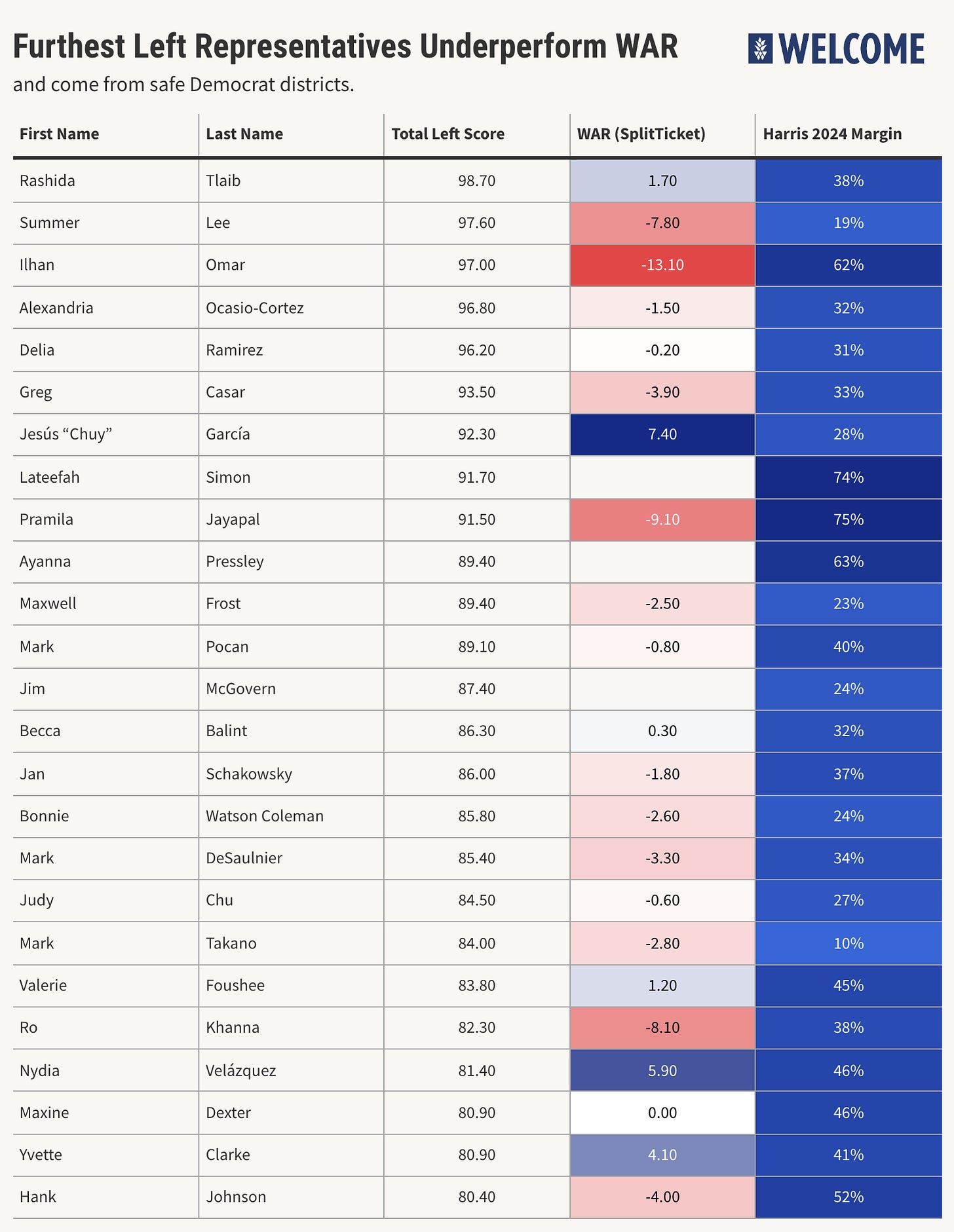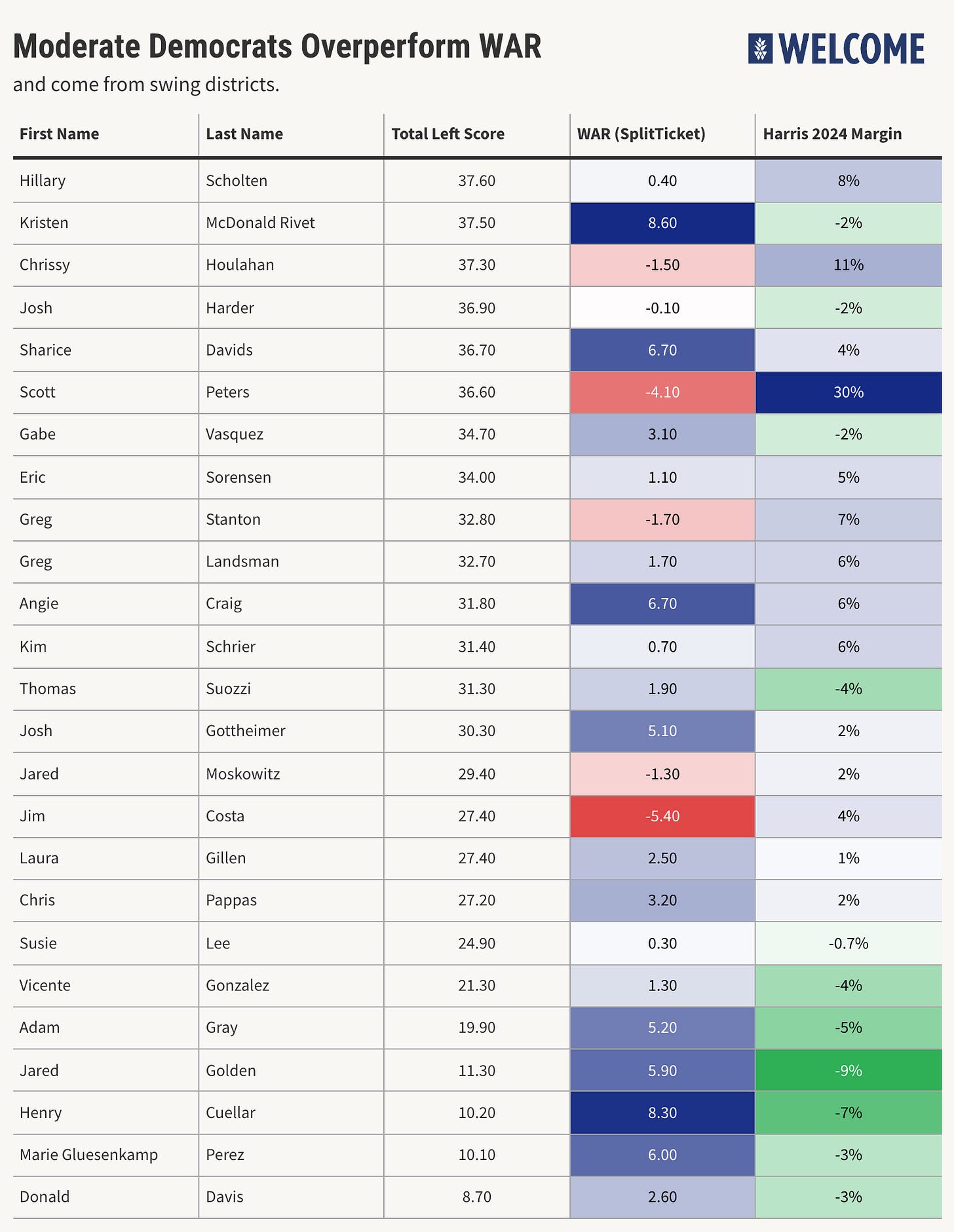Grades on the Literal Purity Test
Democrats are getting lost in the progressive purity test sauce, trading electoral over-performance for progressive accolades.
Activist Aaron Fernando produces a measure he calls the “Left Score” and subsequently ranks every congressional Democrat on how left-wing they are based on that scoring. From a Member’s voting record to endorsements they’ve earned and their caucus membership, it’s a herculean database that spans more than a decade of data (the first vote included regards NSA data), and we applaud Fernando for his research and contribution.
What It Means To Be “Left”
As data nerds ourselves, we were immediately interested. To answer the first question our readers may have, the most left-wing Democrats are Rashida Tlaib (99% on “correct” votes), Summer Lee (98%), Ilhan Omar (97%) and Alexandria Ocasio-Cortez (97%).
Becoming a tried and true leftist is tough. To earn that top spot, Tlaib had to:
vote “No” on requiring the DOJ to report on “targeted attacks on law enforcement officers” (with Summer Lee, AOC, and Delia Ramirez)
Vote “No” on an anti-Semitism resolution (only Ilhan Omar joined)
Vote “No” on the U.S. Customs and Border Protection using more technology to secure the border (with Summer Lee, Ilhan Omar, AOC, and Delia Ramirez)
Vote “No” to creating a strategy for law enforcement cooperation to go after fentanyl and synthetic opioids (with Summer Lee, Ilhan Omar, and Delia Ramirez)
Vote “No” on funding for police recruitment (with Summer Lee, Ilhan Omar, AOC, and Delia Ramirez)
Vote “No” on a ban of PLO members entering the United States (alone, though Delia Ramirez voted “Present”)
Tlaib’s near perfect left score was tainted by voting “Yes” for sanctions on Chinese opioid manufacturers. Unfortunately for her, the “correct” vote for that bill would have been the pro-opioid position.
A perfect left score would also require voting “No” on any omnibus budget that funded the Department of Defense, opposing sanctions on North Korea, and opposing funding for police. In another instance, the “correct” vote on a resolution to call the anti-Semitic Boulder attack part of “a disturbing pattern of targeted aggression against Jewish individuals” would have been “No” (Tlaib voted “Present”).
So when we say “left score” we mean really left. Looking at the above list, regardless of your views on the merits, you can see why maintaining a high left score would be hard (impossible) to do in a swing district.
Sure enough, the lowest left scores belong to centrists in tough districts — places where Trump won in 2024. Those Members include Don Davis (9% left score), Marie Gluesenkamp Perez (10%), Henry Cuellar (10%), Jared Golden (11%), Adam Gray (20%).
Top 25 and Bottom 25
Back in 2018, before launching Welcome, we proposed a concept called the “Left Decile” in The Boston Globe. At the time, the media was obsessed with progressive challengers knocking off incumbents from the left. But we demonstrated that, both in Congress and at the state level, such challenges were only ever successful in the 10% most-left districts.
Outside of this Left Decile, progressive challengers failed.
In the spirit of the “left decile,” we analyzed the 25 highest and 25 lowest scores on Fernando’s left scorecard.
First, we took a look at “WAR” scores from Split Ticket, which measure how a lawmaker compares electorally to a generic Democrat. We found, on average, highly-ranked left score Members underperformed in their districts by 1.9 points. Luckily for them, Harris won their districts by an average of 39 points, so underperformance wouldn’t cost them.
But for those in the bottom 25 on the left score, the story is very different — These Members, on average, over-perform a generic Democrat by 2.3 points, and that’s just enough, since on average they represent seats Harris won by just 2 points.
The Top 25 Most Left Members
The top 25 most left-wing Democrats are all members of the Congressional Progressive Caucus (just one, Valerie Foushee, is also a New Dem). 9 of the 25 were endorsed by Justice Democrats.
Vice President Harris carried all 25 of these districts by a comfortable margin. The closest race was in CA-39, where Harris won by 10 points.
While these lawmakers are at the top of the left list, these districts are safe enough that any candidate with a D next to their name would have won.
The Top 25 Most Moderate Members
The “bottom” 25 Democrats on the left scorecard is a completely different flavor of Democrat.
From a caucus standpoint: 23 are New Dems, 7 are Blue Dogs, and 5 belong to both.
The makeup of their districts is also much different than those at the top of the card — Trump won 11 of the districts, and Harris won 12 of the districts by 8 points or less. Only 2 of the 25 districts saw Harris win by more than 8 points.
Conclusion
The data is clear: a low left score is highly correlated with winning and holding tough seats.
The progressive faction of the Party may have good ideas (at times), but enacting those ideas requires winning tough races. And winning tough races is one metric that doesn’t show up anywhere on the left scorecard.




